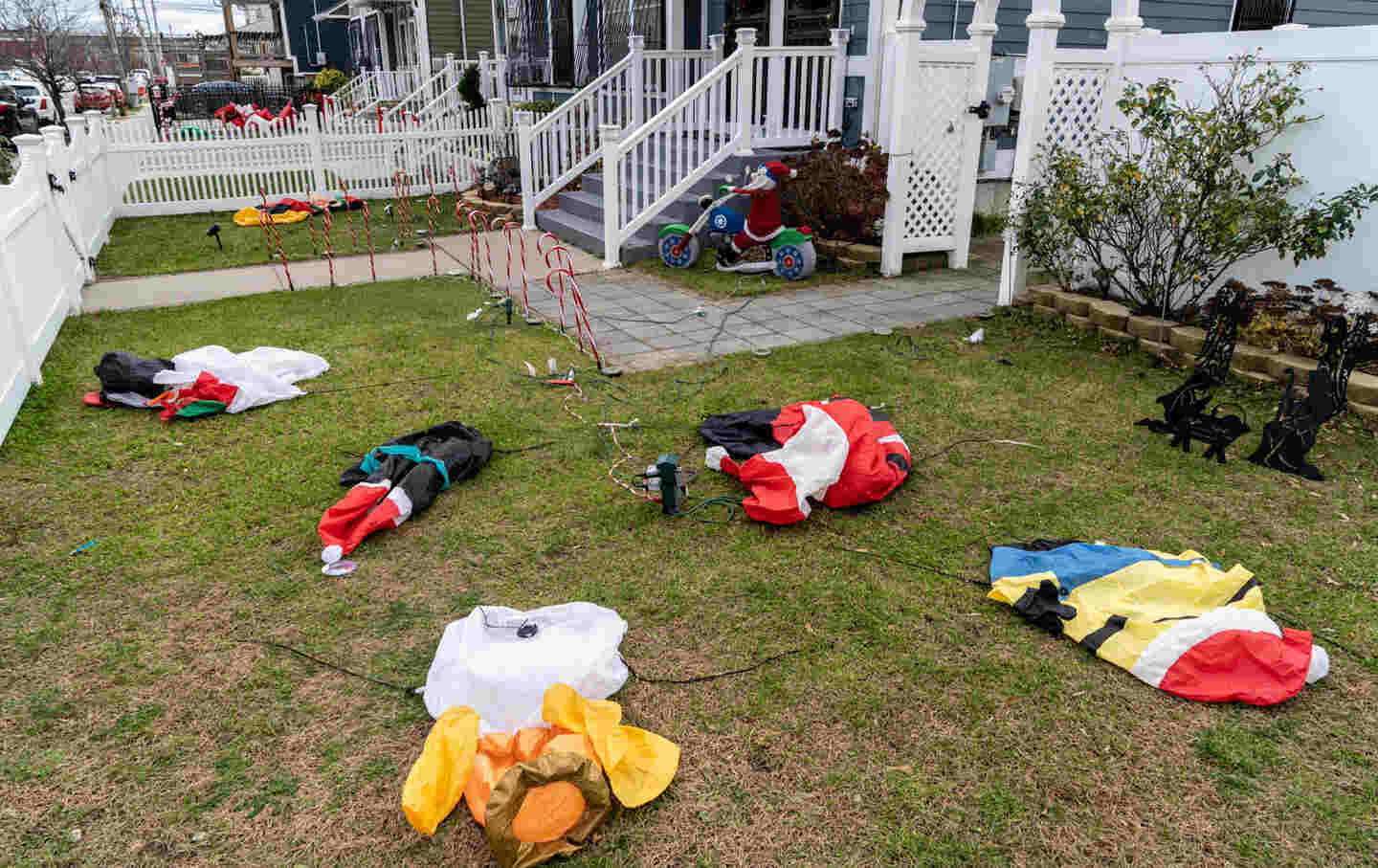
Christmas trees, E. A. Gifts & More, 37-38 Junction Blvd., Queens, November 15, 2020.
Camilo VergaraNearly every day during the almost three years that have passed since the start of the Covid-19 pandemic, I have continued my work as a documentary photographer of urban areas, recording the outward signs of how people and government agencies are dealing with the virus. I wondered how the pandemic might be changing our public spaces. how people of limited income were adapting, and how the pandemic might be influencing race relations. 
Plastic Christmas decorations waiting to be inflated, 337 Beach 40th St, Queens, December 8, 2020.(Camilo Vergara)
Since the virus spread so quickly and unpredictably, going out to photograph every day has remained essential.
Merry Christmas! Musicians and children, Penn Station, Manhattan, December 23, 2020.(Camilo Vergara)
One observation: even in the most adverse situations, people need to celebrate birthdays, Mother’s Day, Halloween, Thanksgiving and, most of all, Christmas. Over time, I’ve been able to chart some of the signs of Christmas celebration during the pandemic. In the holiday seasons of 2020 and 2021, store windows were filled with bright Christmas trees as well as masks for sale and signs reminding shoppers to socially distance. These juxtapositions and others like them in homes and subway stations testified to the coexistence of both a deadly virus and the desire to gather and rejoice.
NW corner of Malcolm X Blvd. and West 125th St., Harlem, December 25, 2020.(Camilo Vergara)
In the current Christmas season, however, the only such juxtaposition I encountered was at LaGuardia Airport, where holiday lights in the shape of stars shared space with signs reading: “WHAT IF COVID-19 COMES HOME FOR THE HOLIDAYS?”
"What if COVID 19 comes home?" La Guardia Airport, Terminal B, Queens, December 6, 2022.(Camilo Vergara)
Gregg GonsalvesSince the start of the pandemic, I’ve chronicled the ups and downs of this viral catastrophe, our response to it as a country for The Nation. My day job is as an epidemiologist; although most of my peers had refocused their work on Covid, I tried to keep working on HIV and substance use—two other American epidemics that either long faded into the background of our lives or were obscured by the new pathogen in our midst.
$0 COST COVID 19 TESTING, West 125th St. at Malcolm X Blvd. Harlem, December 7, 2021.(Camilo Vergara)
I watched the data, the cases rise, the hospitalizations and deaths that followed, and this virus’s march through the very same communities that Camilo photographs, and the disproportionate toll it took on them.
Signs, entrance to Dr. Byagary's Office, 124 Wyckoff Ave. Brooklyn, December 27, 2021.(Camilo Vergara)
In a pandemic, holidays are a blessing and a curse. The isolation of the first months of the pandemic was devastating for many. Seeing those we love is crucial to our survival. And yet, many—vulnerable because of underlying immunosuppression or age—are still deprived of the warmth we associate with the season: greetings at the door, embraces of old friends, gatherings around a table together to eat.
We’ve been told again and again that the “pandemic is over.” We don’t need to worry; Covid has joined the flu and the common cold as traditional winter worries.
P. S. 100 "The Coney Island School" 2951 West 3rd St. Brooklyn, January 10, 2022.(Camilo Vergara)
What we don’t get told is that in the weeks after Christmas and New Year’s, we will see deaths spike up—they are already inching up in the wake of Thanksgiving gatherings. There are few appeals to our common humanity to protect each other beyond the regular ones now to “get vaccinated.” We don’t get told that we could do more. And seldom are we informed that our leaders could give us far more to keep this season from becoming, again, a gruesome trade-off between those treasured moments of togetherness and the fact that tens of thousands of people, newly dead from Covid, will not be here next year to celebrate.
Camilo José VergaraCamilo José Vergara is a photographer and the author of numerous books. You can see Vergara’s photographs documenting the pandemic in the Library of Congress, which houses his archive, and online.
Gregg GonsalvesTwitterNation public health correspondent Gregg Gonsalves is the codirector of the Global Health Justice Partnership and an associate professor of epidemiology at the Yale School of Public Health.